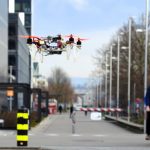 How drones are controlled is an ongoing bone of contention that has largely rendered their use confined to wide open spaces, monitoring utility networks and the like. A major problem has been the speed with which drones can autonomously react to unexpected events in relatively unstructured environments, as in a city for instance.
How drones are controlled is an ongoing bone of contention that has largely rendered their use confined to wide open spaces, monitoring utility networks and the like. A major problem has been the speed with which drones can autonomously react to unexpected events in relatively unstructured environments, as in a city for instance.
A recent study from researchers at the University of Zurich and the National Centre of Competence in Research NCCR Robotics suggests that inspiration could be taken from the way urban modes of transport such as cars and bicycles navigate.
The researchers developed an algorithm, called DroNet, which can safely navigate the drone through the streets of a city. It’s designed to produce two outputs for each image. The first of these is a steering angle to ensure the drones continues to navigate whilst avoiding whatever obstacles are in its path, whilst the second is a collision probability system to allow the drone to identify dangerous situations and react accordingly.
“DroNet recognises static and dynamic obstacles and can slow down to avoid crashing into them. With this algorithm we have taken a step forward towards integrating autonomously navigating drones into our everyday life,” the team say.
Smart navigation
The drones are capable of navigating using standard cameras, much like those found in the average smartphone. The fact that they don’t require sophisticated sensors to make sense of their environment is a significant plus point. Instead, they rely on a deep neural network to do the grunt work.
“This is a computer algorithm that learns to solve complex tasks from a set of ‘training examples’ that show the drone how to do certain things and cope with some difficult situations, much like children learn from their parents or teachers,” the authors say.
As with so many AI projects today, DroNet required a huge volume of training data to get up to speed. The researchers used cars and bikes to provide that data, with the drone then trained to imitate them as much as possible. Interestingly, this training equipped the drones to safely navigate environments they had not previously been exposed to.
Suffice to say, they are still at an early stage in their development, but it’s an interesting project to keep an eye on. You can learn more about DroNet via the video below.